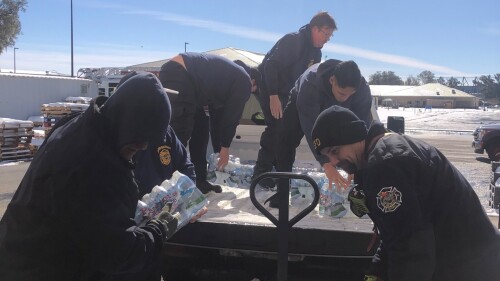A new well-intended law in Florida has some providers scratching their heads and asking questions.
, better known as Florida’s “Halo Law,” which took effect on New Years Day, makes it a misdemeanor crime to harass, threaten, or interfere with EMS providers on emergency scenes.
| MORE: Fla. ‘Halo Law’ creates enforceable boundary around first responders
As written, the law creates a 25-foot zone of safety around first responders while they are on the scene of a call. Anyone who invades that 25-foot zone – with “specified intent” – will be given one warning to vacate the safety zone or face criminal prosecution.
The new law makes disregarding that warning punishable by up to 60 days in jail and a $500 fine.
The statute spells out what “interfere,” “threaten,” and “harass” mean in the context of first responders. It also spells out what a first responder is: a police officer, probation officer, firefighter or EMS provider.
The language of the law
Chaotic scenes and crowd control have been serious issues for EMS since forever. So, the new Halo Law sounds great, right? Well …
First of all, the law does not seem to clearly define what “specified intent” means. Is it the specified intent to simply remain within 25 feet or is it the specified intent to harass, threaten or interfere with first responders? Generally, in the law, specific intent is exactly that, very specific. To commit a specific intent crime, one must specifically intend to do something that is against the law (whether they know it is illegal or not) and then do or attempt that act.
The language right out of the Halo Law statute says, “Approaching a first responder with specified intent after a warning … ” Unfortunately, the problem with “specific intent” is that it requires that the person who is claiming the violation know what the person who committed the violation (allegedly) was thinking at the time of the violation. That is, absent obvious acts, they would have to be psychic. If someone walks up to a provider on an emergency scene and immediately bonks them on the head without warning or provocation, one could infer pretty easily that bonking the provider on the head is what they specifically intended to do. One need not be psychic to draw the correct conclusion.
Determining intent
When we apply the same standard to reality, it is not as clear. In the context of a chaotic scene or one where there is a crowd control issue, the Halo Law is a no-brainer. However, this law can and likely will be invoked far more often in far less dramatic situations. Let’s say that a person enters the 25-foot safety zone and is warned to leave by a paramedic and does, but then the person creeps in again, trips and knocks over a provider. Did the person specifically intend to interfere by knocking the provider over? Is that a violation? Is that a crime?
How about a person who is warned to leave the safety zone, but refuses because they have the patient’s parent, spouse, doctor or lawyer on the phone. Is that a violation? Is that a crime? Neither of those people specifically intended to interfere.
Maybe there are volumes of statutes and case law that define what specified intent means in the context of the Halo Law, but a frontline EMS provider is not going to know any of that, which means they will be left to figure it out on the fly and hope they are not wrong.
When and how to enforce the Halo Law?
Another question, albeit a tad more ticky-tacky, is this: who has the authority to give such a warning? At first glance, it would appear the law states that any first responder on scene could give a warning, but does it, really?
Everyone knows that if a law enforcement officer gives a lawful order – which this would be – one must follow it or be subject to some measure of penalty. What about an EMT crew alone on a medical call? If an EMT is on a medical call and an individual enters the safety zone and the EMT warns the person to vacate, what authority does the EMT have, in the moment, to enforce the Halo Law? Does the EMT take the person into custody? Issue a citation? Summon law enforcement and wait on scene of the medical emergency to make sure the person is arrested? In this scenario, the Halo Law seems to be missing some teeth.
How about photography? What if the person is a “citizen journalist” like the ones that fill my TikTok feed with all their inanity; does the Halo Law trump first amendment-protected activity? If the call is in public and the photographer is not a care provider, HIPAA doesn’t apply. Moreover, a yahoo with an iPhone standing 24-feet away and quietly recording is not necessarily interfering, nor would there appear to be a specific intent to do so. Is mere presence a violation? Is it a crime?
How far do providers go – and at what personal cost – to enforce the Halo Law? I can imagine a thousand scenarios where good-faith enforcement could result in the termination of a provider or, worse, a lawsuit.
Does the penalty fit the crime?
Those are just some of the most obvious top-of-mind questions from a lawyer who is on the outside looking in. Analyzing the law with the provider’s mindset, there are even more relevant questions to answer.
Is 25 feet far enough to ensure adequate provider safety? I’m pretty sure that someone standing 26 feet away yelling obscenities or threatening a provider would be harassing or interfering. Oh, and by the way, who is measuring those 25 feet?
Is a misdemeanor enough? As an example, many of us have been on this call:
A purported gang member suffers a gunshot wound and is in traumatic full arrest. Another gang member with a matte black Glock handle protruding from his waistband tells you that if the patient dies, you die.
I have been on that call.
That is a criminal threat no matter how you parse it. However, other laws notwithstanding, is a 60-day jail sentence and a $500 fine sufficient penalty for that? Clearly, that would constitute a felony criminal threat, but where is the line drawn?
Crowd control and unruly interlopers have plagued first responders since before the days of the bucket brigades, and it seems that, as a starting point, Florida’s Halo Law is an excellent and much-needed first step in finally codifying provider safety.
However, like everything else in this crazy world, there will be a mountain of unintended consequences that will all end up being tested in court. This is the time to try and think of as many complicated scenarios in which the Halo Law will come into play as we can, plan for them, and train our people in how to manage the scene.







